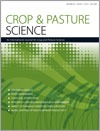The expression and inheritance of several qualitative traits was examined in four cultivated × wild hybrid populations involving each of two mungbean (Vigna radiata ssp. radiata) cultivars, cvv. Berken and Kiloga, and each of two Australian accessions of the wild subspecies (V. radiata ssp. sublobata). One of the wild accessions, ACC 1, was representative of a prostrate, fine-stemmed, gracile type and the other, ACC 87, was representative of a more robust perennial form endemic in north-eastern Australia. For each of the four cultivated × wild populations, trait expression was observed in plants from the parent, F1, F2, and the two F1–parental backcross generations, when grown under favourable conditions in large pots on benches in the field at CSIRO Davies Laboratory, Townsville, Australia. Models of inheritance were inferred based on the segregation patterns in the different generations of the cultivated v. wild phenotypes. For most traits, the model of inheritance depended more on the wild than the cultivated parent, with more traits in the crosses involving ACC 1 being digenic than in those involving ACC 87. For all the observed morphological and seed traits, the wild phenotype was dominant, consistent with the cultivated phenotype having arisen through mutations that inhibited expression of the wild type. In contrast, the apparent resistance of the wild parents to field strains of powdery mildew disease was recessive to the strong susceptibility of the two cultivars. The segregation patterns for presence or absence of tuberous roots were remarkably similar in the two crosses involving the perennial accession ACC 87, and were consistent with the formation of tuberous roots being conditioned by two complementary, dominant genes. The fact that an apparently complex trait like perenniality might be conditioned by so few genes suggested that perenniality may also be an ancestral wild trait, disruption of which has led to the now more common, annual form. Linkage analyses suggested that perenniality was associated with the wild-type seed traits, black speckled testa and pigmented hilum, which previous molecular studies have indicated are both located on mungbean linkage group 2.
How to translate text using browser tools
11 October 2012
Expression and inheritance of perenniality and other qualitative traits in hybrids between mungbean cultivars and Australian wild accessions
Thuan D. Nguyen,
R. J. Lawn,
L. M. Bielig
ACCESS THE FULL ARTICLE

Crop and Pasture Science
Vol. 63 • No. 7
October 2012
Vol. 63 • No. 7
October 2012
Adaptation
morphology
phenology
tuberous roots
Vigna radiata ssp. sublobata





